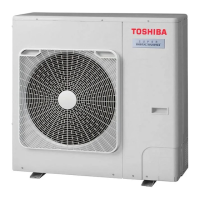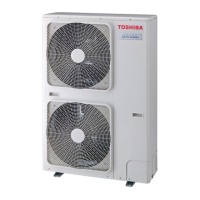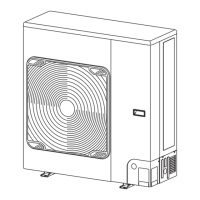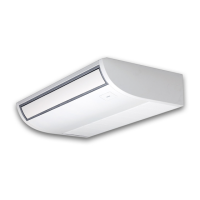Do you have a question about the Toshiba RAV-GP801AT-E and is the answer not in the manual?
Explains the use of R32 refrigerant in the air conditioner.
Details compliance with harmonic current regulations.
Defines the qualifications for personnel performing installation and service.
Specifies required protective gear for various work tasks.
Explains the meaning of warning and caution symbols used in the manual.
Details warnings related to electrical hazards and moving parts.
Covers warnings about high temperatures and potential burst hazards.
Covers general safety, qualified personnel, refrigerant handling, and transport precautions.
Addresses safety for working at heights and handling the outdoor unit.
Discusses refrigerant properties, leaks, and safe handling during installation.
Outlines criteria for selecting a suitable installation location.
Details requirements for refrigerant piping and performing airtight tests.
Covers electrical wiring standards and essential earthing procedures.
Describes the process for conducting a test run and explaining the unit to the user.
Provides safety guidelines for relocating the air conditioner.
Highlights specific cautions related to R32 refrigerant.
Specifies requirements for the space around the outdoor unit.
Lists and describes the included accessory parts.
Details tools and equipment needed for R32 refrigerant air conditioner installation.
Specifies allowable lengths for refrigerant pipes.
Details pipe material, thickness, and support requirements.
Explains the steps for airtight testing and air purging.
Covers requirements and restrictions for outdoor unit installation locations.
Provides diagrams and dimensions for required installation space.
Details procedures for installing the outdoor unit base and foundation.
Covers refrigerant piping connection and removing service panels.
Important points for connecting refrigerant pipes and optional parts.
Step-by-step guide for flaring pipes and tightening connections.
Tables detailing allowable refrigerant pipe lengths and diameters.
Steps for performing airtight tests and checking for gas leaks.
Instructions for purging air from the system using a vacuum pump.
Detailed steps for using the vacuum pump for evacuation.
Guidance on opening valves and tightening caps with correct torque.
Formulas and guidelines for adding refrigerant based on pipe length.
Instructions for insulating refrigerant pipes to prevent condensation.
Instructions for applying the refrigerant label and recording quantities.
Covers wiring standards, connections, and safety precautions.
Diagram and instructions for connecting indoor and outdoor units.
Details required power supply, wire sizes, and fuses.
Emphasizes the necessity of proper earthing for safety.
Covers final finishing touches and preparing for the test run.
Advises on regular cleaning and maintenance for optimal performance.
Specifies the recommended temperature ranges for cooling and heating.
Guidelines for checking and using existing refrigerant piping.
Detailed procedure for recovering refrigerant from the system.
Explains how to diagnose faults using LED indicators on the unit.
Procedure for resetting unit settings to factory defaults.
General instructions for reusing existing refrigerant pipes.
Lists conditions under which existing pipes should not be reused.
Provides tables for calculating minimum floor area based on refrigerant quantity.
Details the sound pressure levels and weights of different models.
States compliance with relevant directives and standards.
Warns about refrigerant concentration limits in rooms.
Explains the use of R32 refrigerant in the air conditioner.
Details compliance with harmonic current regulations.
Defines the qualifications for personnel performing installation and service.
Specifies required protective gear for various work tasks.
Explains the meaning of warning and caution symbols used in the manual.
Details warnings related to electrical hazards and moving parts.
Covers warnings about high temperatures and potential burst hazards.
Covers general safety, qualified personnel, refrigerant handling, and transport precautions.
Addresses safety for working at heights and handling the outdoor unit.
Discusses refrigerant properties, leaks, and safe handling during installation.
Outlines criteria for selecting a suitable installation location.
Details requirements for refrigerant piping and performing airtight tests.
Covers electrical wiring standards and essential earthing procedures.
Describes the process for conducting a test run and explaining the unit to the user.
Provides safety guidelines for relocating the air conditioner.
Highlights specific cautions related to R32 refrigerant.
Specifies requirements for the space around the outdoor unit.
Lists and describes the included accessory parts.
Details tools and equipment needed for R32 refrigerant air conditioner installation.
Specifies allowable lengths for refrigerant pipes.
Details pipe material, thickness, and support requirements.
Explains the steps for airtight testing and air purging.
Covers requirements and restrictions for outdoor unit installation locations.
Provides diagrams and dimensions for required installation space.
Details procedures for installing the outdoor unit base and foundation.
Covers refrigerant piping connection and removing service panels.
Important points for connecting refrigerant pipes and optional parts.
Step-by-step guide for flaring pipes and tightening connections.
Tables detailing allowable refrigerant pipe lengths and diameters.
Steps for performing airtight tests and checking for gas leaks.
Instructions for purging air from the system using a vacuum pump.
Detailed steps for using the vacuum pump for evacuation.
Guidance on opening valves and tightening caps with correct torque.
Formulas and guidelines for adding refrigerant based on pipe length.
Instructions for insulating refrigerant pipes to prevent condensation.
Instructions for applying the refrigerant label and recording quantities.
Covers wiring standards, connections, and safety precautions.
Diagram and instructions for connecting indoor and outdoor units.
Details required power supply, wire sizes, and fuses.
Emphasizes the necessity of proper earthing for safety.
Covers final finishing touches and preparing for the test run.
Advises on regular cleaning and maintenance for optimal performance.
Specifies the recommended temperature ranges for cooling and heating.
Guidelines for checking and using existing refrigerant piping.
Detailed procedure for recovering refrigerant from the system.
Explains how to diagnose faults using LED indicators on the unit.
Procedure for resetting unit settings to factory defaults.
General instructions for reusing existing refrigerant pipes.
Lists conditions under which existing pipes should not be reused.
Provides tables for calculating minimum floor area based on refrigerant quantity.
Details the sound pressure levels and weights of different models.
States compliance with relevant directives and standards.
Warns about refrigerant concentration limits in rooms.
| Brand | Toshiba |
|---|---|
| Model | RAV-GP801AT-E |
| Category | Air Conditioner |
| Language | English |











